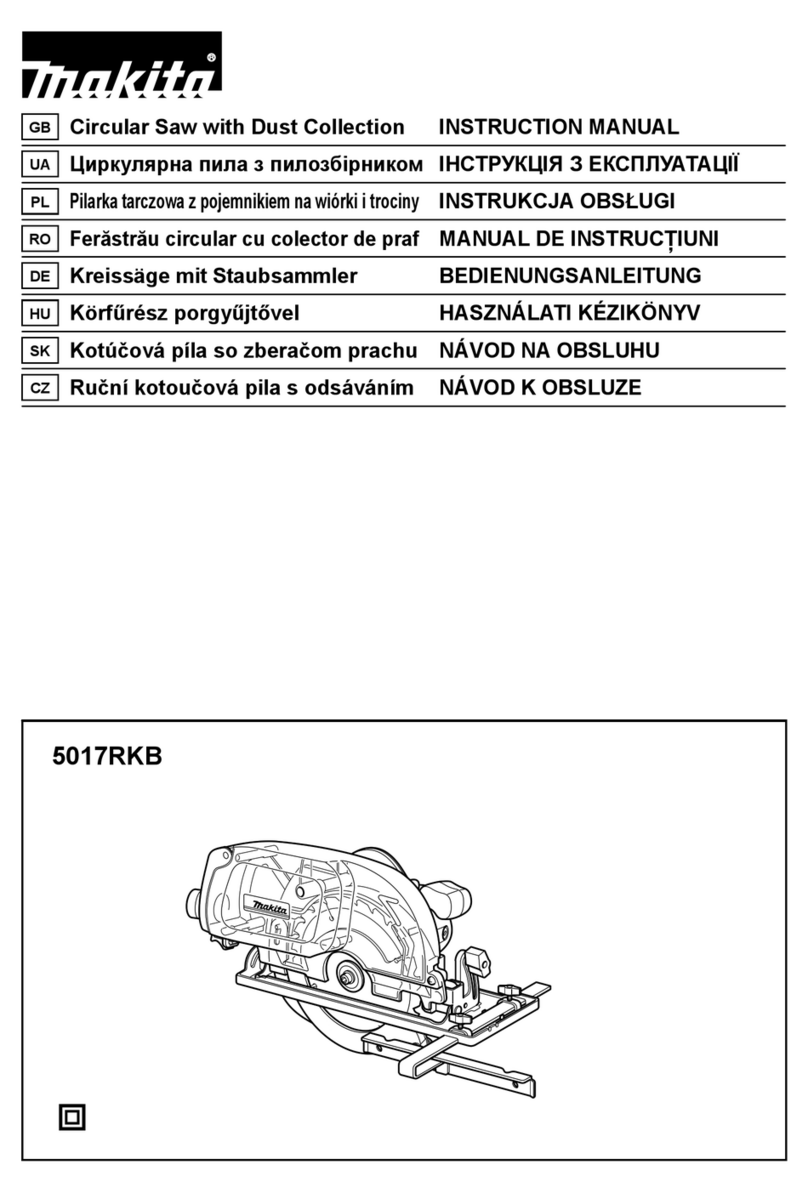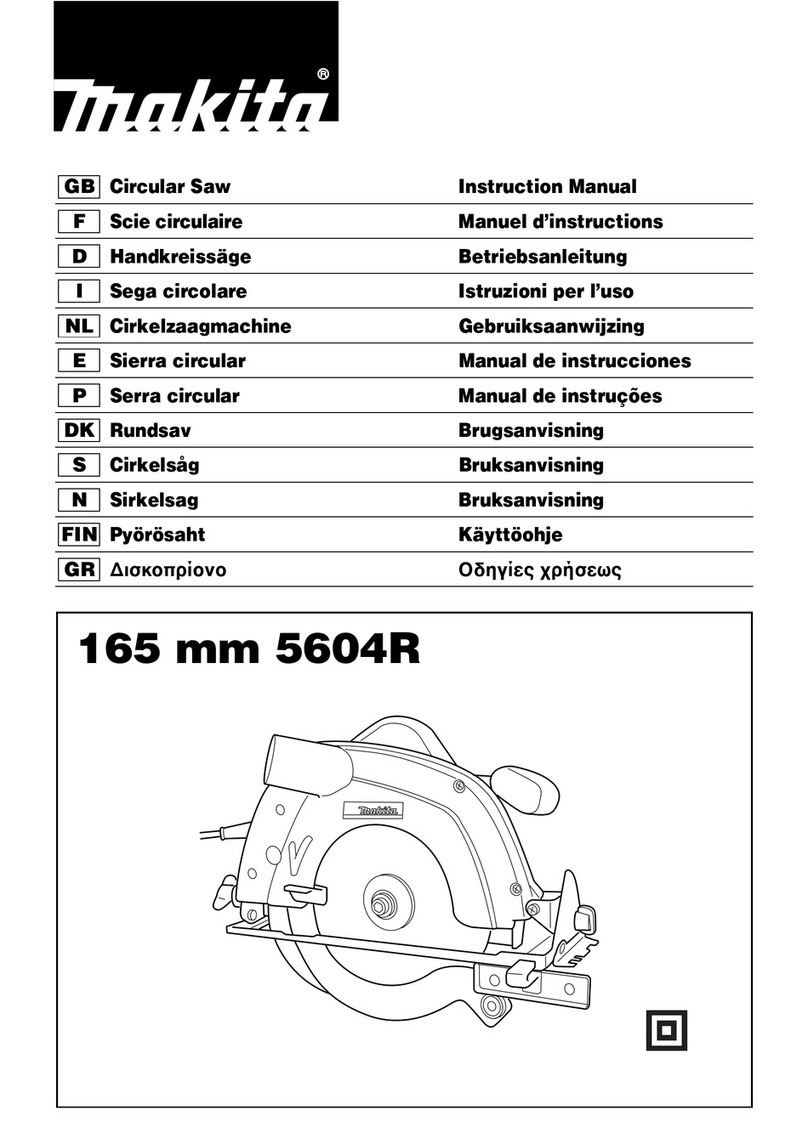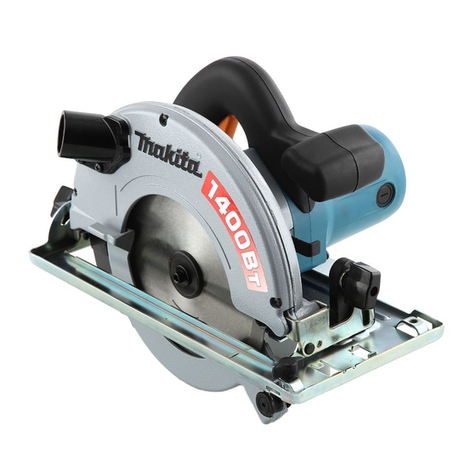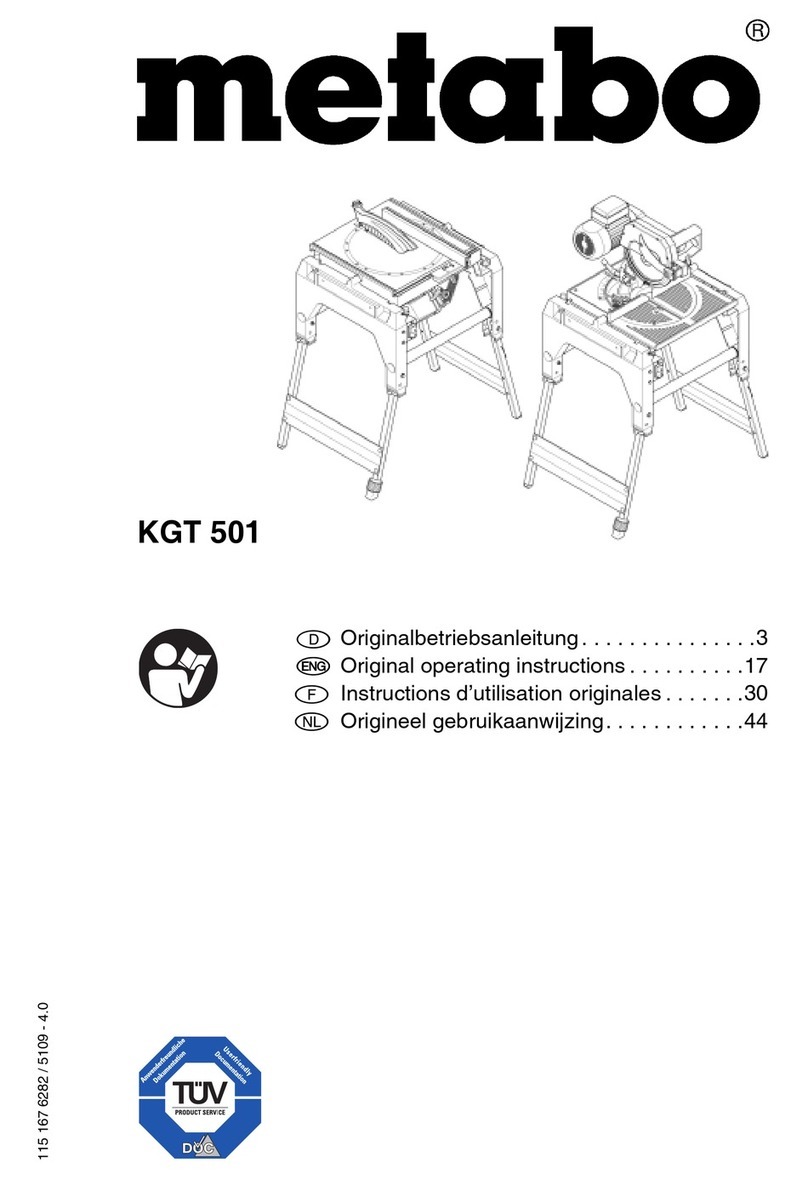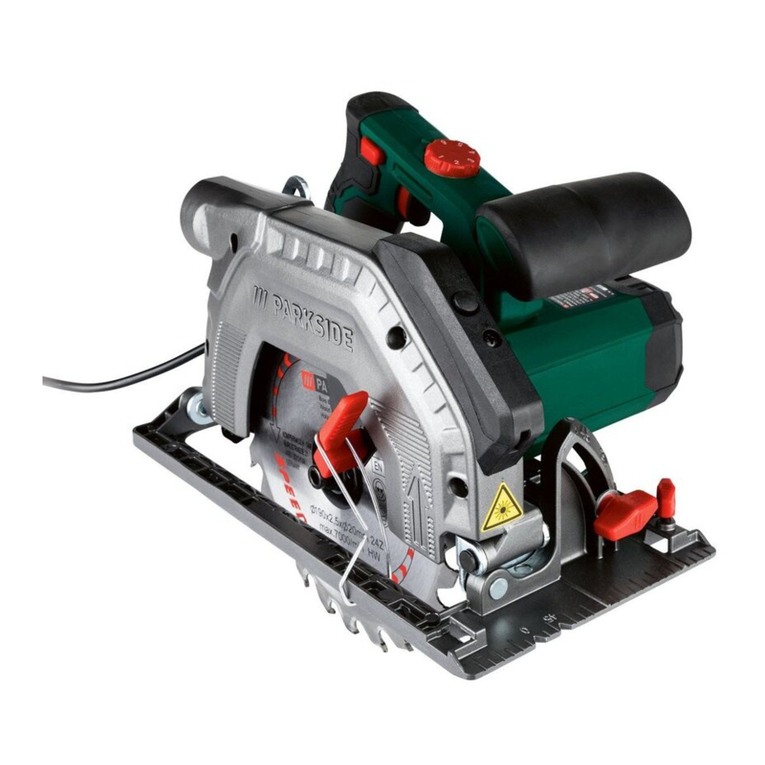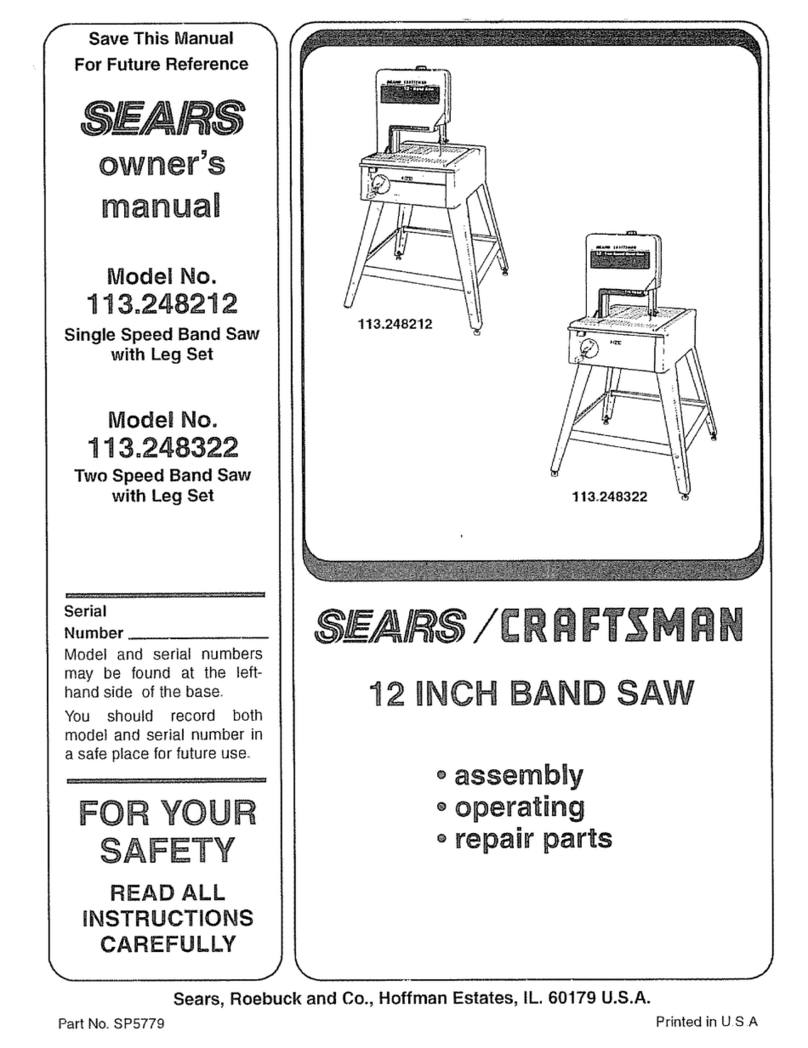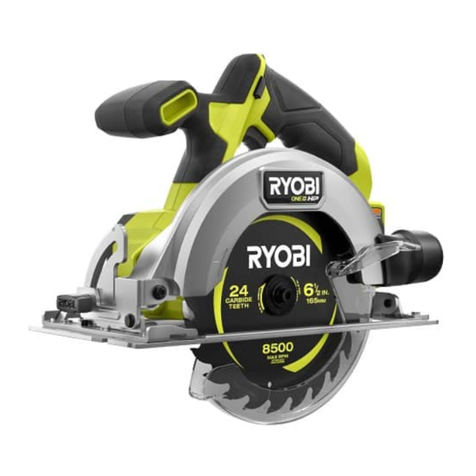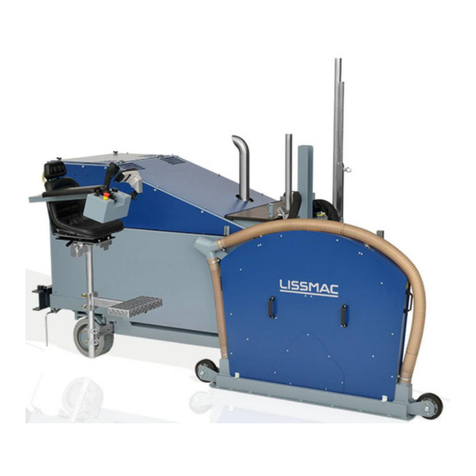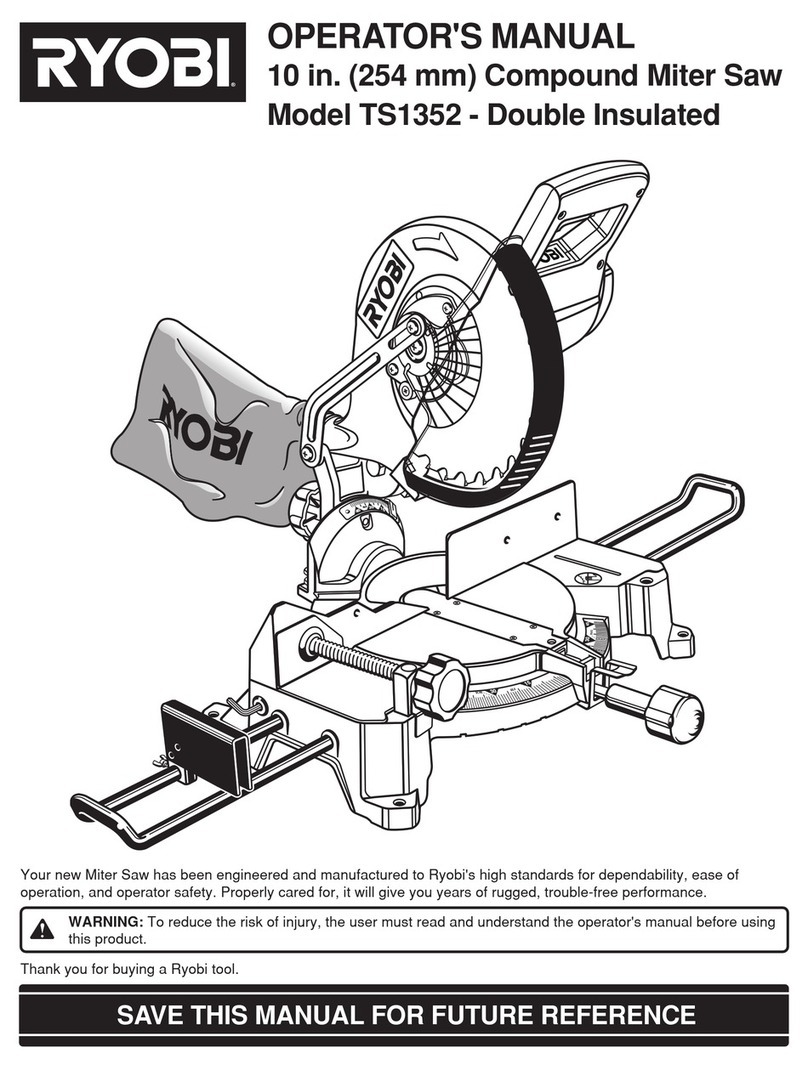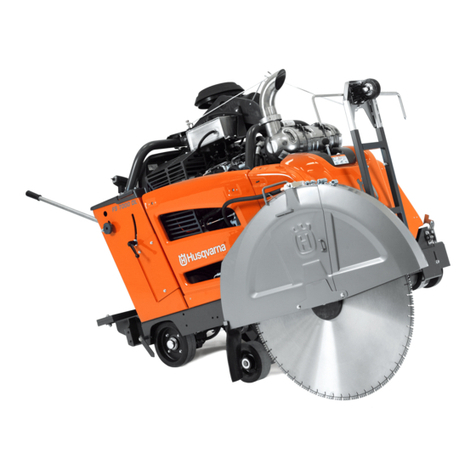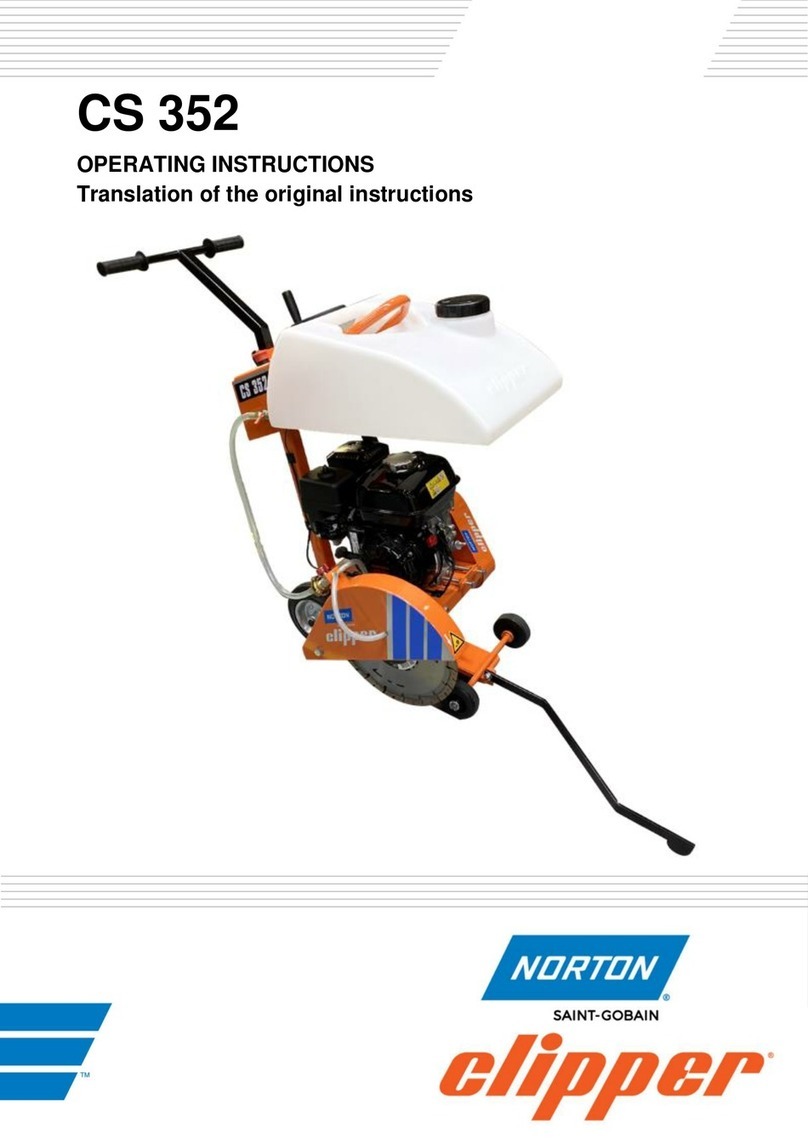Makita M2300 User manual

M2300
EN Compound Miter Saw INSTRUCTION MANUAL 8
FR Scie à Coupe d’Onglet MANUEL D’INSTRUCTIONS 17
DE Kapp-und Gehrungssäge BETRIEBSANLEITUNG 27
IT Troncatrice composita ISTRUZIONI PER L’USO 37
NL Samengesteld-verstekzaag GEBRUIKSAANWIJZING 47
ES Sierra De Inglete Mixta MANUAL DE
INSTRUCCIONES 57
PT Serra de Esquadria MANUAL DE INSTRUÇÕES 67
DA Kombineret geringssav BRUGSANVISNING 77
EL 86
TR KULLANMA KILAVUZU 96

2
Fig.1
1
Fig.2
1
Fig.3
1
2
3
Fig.4
1
Fig.5
1
Fig.6
1
Fig.7
1
Fig.8

3
1
Fig.9
1
Fig.10
2
1
3
130mm
Fig.11
1
2
Fig.12
1
Fig.13
1
Fig.14
1
2
Fig.15
1
2
Fig.16

4
1
Fig.17
1
2
Fig.18
12
3
4
Fig.19
1
23
4
5
6
Fig.20
1
Fig.21
Fig.22
1
Fig.23
1
Fig.24

5
12
Fig.25
1
2
4
3
Fig.26
1
Fig.27
Fig.28
123
Fig.29
(a) (b) (c) (d)
12
Fig.30
2
(a)
(b)
(a)
(b)
(b)
(a)
(b)
(a)
(a)
(b)
(c)
(d)
1
Fig.31
2
3
1
4
Fig.32

6
(a) (b) (c) (d)
12
Fig.33
1
2
3
4
5
Fig.34
≥ 10mm ≥ 460mm
11
25mm
100mm115mm 100mm115mm
Fig.35
1
2
3
Fig.36
1
Fig.37
Fig.38
11
Fig.39
1
Fig.40

7
1
Fig.41
1
2
3
Fig.42
1
Fig.43
1
2
Fig.44
Fig.45
1
2
Fig.46

8ENGLISH
ENGLISH (Original instructions)
SPECIFICATIONS
Model: M2300
Blade diameter 255 mm
Hole diameter For all countries other than
European countries
25.4 mm or 30 mm
For European countries 30 mm
Max. kerf thickness of the saw blade 3.2 mm
No load speed 4,200 min-1
610 mm x 485 mm x 515 mm
Net weight 13.8 kg
Safety class /II
without notice.
• Weight according to EPTA-Procedure 01/2014
Cutting capacities (H x W) with blade 255 mm in diameter
Bevel angle Miter angle
0° 45° (left and right)
0° 75 mm x 130 mm 75 mm x 90 mm
48 mm x 120 mm 48 mm x 90 mm
Symbols
The followings show the symbols which may be used
for the equipment. Be sure that you understand their
meaning before use.
Read instruction manual.
DOUBLE INSULATION
holding the saw head down, after making
cuts, until the blade has come to a com-
plete stop.
blade.
Always set SUB-FENCE to left position
when performing left bevel cuts. Failure to
Only for EU countries
Due to the presence of hazardous compo-
nents in the equipment, used electrical and
electronic equipment may have a negative
impact on the environment and human
health.
Do not dispose of electrical and electronic
appliances with household waste!
In accordance with the European Directive
on waste electrical and electronic equip-
ment and its adaptation to national law,
used electrical and electronic equipment
should be collected separately and
delivered to a separate collection point
for municipal waste, operating in accor-
dance with the environmental protection
regulations.
This is indicated by the symbol of the
crossed-out wheeled bin placed on the
equipment.
Intended use
The tool is intended for accurate straight and miter
cutting in wood. With appropriate saw blades, aluminum
can also be sawed.
Power supply
The tool should be connected only to a power supply of
the same voltage as indicated on the nameplate, and
can only be operated on single-phase AC supply. They
are double-insulated and can, therefore, also be used
from sockets without earth wire.

9ENGLISH
Noise
The typical A-weighted noise level determined accord-
ing to EN62841-3-9:
Sound pressure level (LpA
Sound power level (LWA
NOTE:
been measured in accordance with a standard test
method and may be used for comparing one tool with
another.
NOTE:
may also be used in a preliminary assessment of
exposure.
WARNING: Wear ear protection.
WARNING: The noise emission during actual
value(s) depending on the ways in which the
tool is used especially what kind of workpiece is
processed.
WARNING: Be sure to identify safety mea-
sures to protect the operator that are based on an
estimation of exposure in the actual conditions of
use (taking account of all parts of the operating
cycle such as the times when the tool is switched
trigger time).
EC Declaration of Conformity
For European countries only
The EC declaration of conformity is included as Annex A
to this instruction manual.
SAFETY WARNINGS
General power tool safety warnings
WARNING: Read all safety warnings, instruc-
with this power tool. Failure to follow all instructions
Save all warnings and instruc-
tions for future reference.
The term "power tool" in the warnings refers to your
Safety instructions for mitre saws
1. Mitre saws are intended to cut wood or wood-
like products, they cannot be used with abra-
such as bars, rods, studs, etc. Abrasive dust
causes moving parts such as the lower guard to
lower guard, the kerf insert and other plastic parts.
2.
Use clamps to support the workpiece whenever
possible. If supporting the workpiece by hand, you
must always keep your hand at least 100 mm from
either side of the saw blade. Do not use this saw to
cut pieces that are too small to be securely clamped
or held by hand. If your hand is placed too close to
blade contact.
3.
The workpiece must be stationary and clamped or
held against both the fence and the table. Do not
feed the workpiece into the blade or cut "freehand"
in any way. Unrestrained or moving workpieces could
4.
Never cross your hand over the intended line of
cutting either in front or behind the saw blade.
Supporting the workpiece "cross handed" i.e. holding
the workpiece to the right of the saw blade with your left
hand or vice versa is very dangerous.
Fig.1
5. Do not reach behind the fence with either hand
closer than 100 mm from either side of the saw
blade, to remove wood scraps, or for any other
reason while the blade is spinning. The proxim-
ity of the spinning saw blade to your hand may not
6. Inspect your workpiece before cutting. If the
workpiece is bowed or warped, clamp it with
the outside bowed face toward the fence.
Always make certain that there is no gap
between the workpiece, fence and table along
the line of the cut. Bent or warped workpieces
can twist or shift and may cause binding on the
spinning saw blade while cutting. There should be
7. Do not use the saw until the table is clear of all
tools, wood scraps, etc., except for the work-
piece. Small debris or loose pieces of wood or
be thrown with high speed.
8.
Cut only one workpiece at a time. Stacked multiple
workpieces cannot be adequately clamped or braced
and may bind on the blade or shift during cutting.
9. Ensure the mitre saw is mounted or placed on
A level
saw becoming unstable.
10.
Plan your work. Every time you change the bevel or
mitre angle setting, make sure the adjustable fence
is set correctly to support the workpiece and will
not interfere with the blade or the guarding system.
Without turning the tool "ON" and with no workpiece
on the table, move the saw blade through a complete
simulated cut to assure there will be no interference or
danger of cutting the fence.
11.
Provide adequate support such as table extensions,
saw horses, etc. for a workpiece that is wider or
longer than the table top. Workpieces longer or wider
than the mitre saw table can tip if not securely sup-
the lower guard or be thrown by the spinning blade.
12.
Do not use another person as a substitute for a
table extension or as additional support. Unstable
support for the workpiece can cause the blade to bind
or the workpiece to shift during the cutting operation
pulling you and the helper into the spinning blade.

10 ENGLISH
13.
pressed by any means against the spinning
saw blade.
and thrown violently.
14.
properly support round material such as rods
or tubing. Rods have a tendency to roll while
being cut, causing the blade to "bite" and pull the
work with your hand into the blade.
15. Let the blade reach full speed before contact-
ing the workpiece. This will reduce the risk of the
workpiece being thrown.
16. If the workpiece or blade becomes jammed,
parts to stop and disconnect the plug from
the power source and/or remove the battery
pack. Then work to free the jammed material.
cause loss of control or damage to the mitre saw.
17.
hold the saw head down and wait for the blade
Reaching with your hand near the coasting blade
is dangerous.
18. -
plete cut or when releasing the switch before
the saw head is completely in the down posi-
tion. The braking action of the saw may cause
the saw head to be suddenly pulled downward,
19. Only use the saw blade with the diameter that
-
ual.
the proper guarding of the blade or guard opera-
20. Only use the saw blades that are marked with
a speed equal or higher than the speed marked
on the tool.
21. Do not use the saw to cut other than wood,
aluminum or similar materials.
22. (For European countries only)
Always use the blade which conforms to
EN847-1.
Additional instructions
1. Make workshop kid proof with padlocks.
2. Never stand on the tool.
occur if the tool is tipped or if the cutting tool is
unintentionally contacted.
3. Never leave the tool running unattended. Turn
to a complete stop.
4. Do not operate saw without guards in place.
Check blade guard for proper closing before
each use. Do not operate saw if blade guard
does not move freely and close instantly.
Never clamp or tie the blade guard into the
open position.
5. Keep hands out of path of saw blade. Avoid
contact with any coasting blade. It can still
cause severe injury.
6. Always secure all moving portions before
carrying the tool.
7. Stopper pin which locks the cutter head down
is for carrying and storage purposes only and
not for any cutting operations.
8. Check the blade carefully for cracks or dam-
age before operation. Replace cracked or dam-
aged blade immediately. Gum and wood pitch
hardened on blades slows saw and increases
potential for kickback. Keep blade clean by
gum and pitch remover, hot water or kerosene.
Never use gasoline to clean blade.
9.
10.
(especially the installing surface) or bolt.
Damage to these parts could result in blade
breakage.
11. Make sure that the turn base is properly
secured so it will not move during operation.
Use the holes in the base to fasten the saw to a
stable work platform or bench. NEVER use tool
where operator positioning would be awkward.
12. Make sure the shaft lock is released before the
switch is turned on.
13. Be sure that the blade does not contact the
turn base in the lowest position.
14.
moves up or down slightly during start-up and
stopping.
15. Make sure the blade is not contacting the
workpiece before the switch is turned on.
16. Before using the tool on an actual workpiece,
let it run for a while. Watch for vibration or
wobbling that could indicate poor installation
or a poorly balanced blade.
17. Stop operation immediately if you notice any-
thing abnormal.
18. Do not attempt to lock the trigger in the "ON"
position.
19. Always use accessories recommended in this
manual. Use of improper accessories such as
abrasive wheels may cause an injury.
20. Some material contains chemicals which may
be toxic. Take caution to prevent dust inhala-
tion and skin contact. Follow material supplier
safety data.
Additional safety rules for the laser
1. LASER RADIATION, DO NOT STARE INTO THE
BEAM OR VIEW DIRECTLY WITH OPTICAL
INSTRUMENTS, CLASS 2M LASER PRODUCT.
SAVE THESE INSTRUCTIONS.
WARNING: DO NOT let comfort or familiarity
with product (gained from repeated use) replace
strict adherence to safety rules for the subject
product. MISUSE or failure to follow the safety
rules stated in this instruction manual may cause
serious personal injury.

11 ENGLISH
INSTALLATION
When the tool is shipped, the handle is locked in the
lowered position by the stopper pin. Loosen the bolt
with a wrench provided with the tool and move the saw
head to the right angle. Remove the bolt and secure the
saw head with the knob.
Fig.2: 1. Wrench
Fig.3: 1. Knob
Installing auxiliary plate
Installing the auxiliary plate using the hole in the tool's
base and secure it by tightening the screw.
Fig.4: 1. Auxiliary plate 2. Screw 3. Base
Bench mounting
When the tool is shipped, the handle is locked in the
lowered position by the stopper pin. Release the stop-
per pin by lowering the handle slightly and pulling the
stopper pin.
Fig.5: 1. Stopper pin
This tool should be bolted with four bolts to a level and
stable surface using the bolt holes provided in the tool's
Fig.6: 1. Bolt
FUNCTIONAL DESCRIPTION
CAUTION: Always be sure that the tool is
checking function on the tool.
Blade guard
Fig.7: 1. Blade guard
When lowering the handle, the blade guard rises auto-
matically. The guard is spring loaded so it returns to
its original position when the cut is completed and the
handle is raised. NEVER DEFEAT OR REMOVE THE
BLADE GUARD OR THE SPRING WHICH ATTACHES
TO THE GUARD.
In the interest of your personal safety, always maintain
the blade guard in good condition. Any irregular opera-
tion of the blade guard should be corrected immediately.
Check to assure spring loaded return action of guard.
NEVER USE THE TOOL IF THE BLADE GUARD OR
SPRING IS DAMAGED, FAULTY OR REMOVED.
DOING SO IS HIGHLY DANGEROUS AND CAN
CAUSE SERIOUS PERSONAL INJURY.
If the see-through blade guard becomes dirty, or saw-
dust adheres to it in such a way that the blade and/or
workpiece is no longer easily visible, unplug the saw
and clean the guard carefully with a damp cloth. Do not
use solvents or any petroleum-based cleaners on the
plastic guard.
If the blade guard is especially dirty and vision through
the guard is impaired, use the supplied wrench to
loosen the hex bolt holding the center cover. Loosen
the hex bolt by turning it counterclockwise and raise
the blade guard and center cover. With the blade guard
so positioned, cleaning can be more completely and
reverse procedure above and secure bolt. Do not
remove spring holding blade guard. If guard becomes
discolored through age or UV light exposure, contact
a Makita service center for a new guard. DO NOT
DEFEAT OR REMOVE GUARD.
Fig.8: 1. Blade guard
Kerf board
This tool is provided with the kerf board in the turn base
to minimize tearing on the exit side of a cut. If the kerf
groove has not yet been cut in the kerf board by the
factory, you should cut the groove before actually using
the tool to cut a workpiece. Switch on the tool and lower
the blade gently to cut a groove in the kerf board.
Fig.9: 1. Kerf board
Maintaining maximum cutting
capacity
cutting capacity for a 255 mm saw blade.
When installing a new blade, always check the lower
follows:
First, unplug the tool. Lower the handle completely. Use
of the blade extends slightly below the top surface of
the turn base at the point where the front face of the
guide fence meets the top surface of the turn base.
Fig.10: 1.
With the tool unplugged, rotate the blade by hand while
holding the handle all the way down to be sure that
the blade does not contact any part of the lower base.
Fig.11: 1. Top surface of turn base 2. Periphery of
blade 3. Guide fence
CAUTION: After installing a new blade,
always be sure that the blade does not contact
any part of the lower base when the handle is
lowered completely. Always do this with the tool
unplugged.
Adjusting the miter angle
Fig.12: 1. Lock lever 2. Grip
Loosen the grip by turning counterclockwise. Turn the
turn base while pressing down the lock lever. When you
have moved the grip to the position where the pointer
points to the desired angle on the miter scale, securely
tighten the grip clockwise.
CAUTION: When turning the turn base, be
sure to raise the handle fully.
CAUTION: After changing the miter angle,
always secure the turn base by tightening the grip

12 ENGLISH
Adjusting the bevel angle
Fig.13: 1. Knob
the tool counterclockwise.
Fig.14: 1. Pointer
Push the handle to the left to tilt the saw blade until the
pointer points to the desired angle on the bevel scale.
CAUTION: When tilting the saw blade, be sure
to raise the handle fully.
CAUTION: After changing the bevel angle,
always secure the arm by tightening the knob
clockwise.
Switch action
WARNING: Before plugging in the tool,
always check to see that the switch trigger actu-
ates properly and returns to the "OFF" position
when released. Operating a tool with a switch that
does not actuate properly can lead to loss of control
WARNING: NEVER use tool without a fully
operative switch trigger. Any tool with an inoper-
ative switch is HIGHLY DANGEROUS and must be
repaired before further usage or serious personal
Fig.15: 1. Switch trigger 2.
To prevent the switch trigger from being accidentally
Release the switch trigger to stop.
ASSEMBLY
CAUTION: Always be sure that the tool is
any work on the tool.
Installing or removing saw blade
CAUTION: Always be sure that the tool is
removing the blade.
CAUTION: Use only the Makita wrench pro-
vided to install or remove the blade. Failure to
tightening of the hex bolt. This could cause an
injury.
When removing or installing the blade, keep the handle
in the raised position.
To remove the blade, use the wrench to loosen the hex
bolt holding the center cover by turning it counterclock-
wise. Raise the blade guard and center cover.
Fig.16: 1. Wrench 2. Center cover
Fig.17: 1. Hex bolt
Press the shaft lock to lock the spindle and use the
wrench to loosen the hex bolt clockwise. Then remove
Fig.18: 1. Hex bolt 2. Wrench
To install the blade, mount it carefully onto the spindle,
making sure that the direction of the arrow on the sur-
face of the blade matches the direction of the arrow on
the blade case.
Fig.19: 1. Blade case 2. Arrow 3. Arrow 4. Saw
blade
counterclockwise while pressing the shaft lock.
Fig.20: 1. Spindle 2. Flange 3. Saw blade 4. Flange
5. Hex bolt 6. Ring
CAUTION: The ring 25.4 mm or 30 mm in
outer diameter is factory-installed onto the spin-
dle. Before mounting the blade onto the spindle,
always be sure that the correct ring for the arbor
hole of the blade you intend to use is installed
onto the spindle.
Return the blade guard and center cover to its original
position. Then tighten the hex bolt clockwise to secure
the center cover. Lower the handle to make sure that
the blade guard moves properly. Make sure shaft lock
has released spindle before making cut.
Sub-fence
WARNING: When performing left bevel cuts,
Otherwise, it may con-
tact the blade or a part of the tool, and may result in
Fig.21: 1. Sub-fence
This tool is equipped with the sub-fence. Usually posi-
tion the sub-fence inside. However, when performing
Connecting a vacuum cleaner
When you wish to perform clean cutting operation,
connect a Makita vacuum cleaner.
Fig.22
Dust bag
Fig.23: 1. Dust bag
Fig.24: 1. Fastener
The use of the dust bag makes cutting operations clean
onto the dust nozzle.
When the dust bag is about half full, remove the dust
bag from the tool and pull the fastener out. Empty
the dust bag of its contents, tapping it lightly so as to
remove particles adhering to the insides which might
hamper further collection.

13 ENGLISH
Securing workpiece
WARNING: It is extremely important to always
secure the workpiece properly and tightly with
the vise. Failure to do so can cause the tool to be
damaged and/or the workpiece to be destroyed.
PERSONAL INJURY MAY ALSO RESULT. Also,
after a cutting operation, DO NOT raise the blade
until the blade has come to a complete stop.
CAUTION:
When cutting long workpieces, use
supports that are as high as the top surface level of the
turn base. Do not rely solely on the vertical vise and/or
horizontal vise to secure the workpiece. Thin material
tends to sag. Support workpiece over its entire length
to avoid blade pinch and possible KICKBACK.
Fig.25: 1. Support 2. Turn base
Vertical vise
Fig.26: 1. Vise knob 2. Screw 3. Vise arm 4. Vise
rod
The vertical vise can be installed in two positions on
either the left or right side of the guide fence. Insert the
vise rod into the hole in the guide fence and tighten the
screw to secure the vise rod.
Position the vise arm according to the thickness and
shape of the workpiece and secure the vise arm by
tightening the screw. Make sure that no part of the tool
contacts the vise when lowering the handle all the way.
If some part contacts the vise, re-position the vise.
turn base. Position the workpiece at the desired cutting
CAUTION: The workpiece must be secured
the vise during all operations.
OPERATION
CAUTION: Before use, be sure to release the
handle from the lowered position by pulling the
stopper pin.
CAUTION:
Make sure the blade is not contacting
the workpiece, etc. before the switch is turned on.
CAUTION: Do not apply excessive pressure
on the handle when cutting. Too much force may
result in overload of the motor and/or decreased cut-
force as necessary for smooth cutting and without
CAUTION: Gently press down the handle
to perform the cut. If the handle is pressed down
with force or if lateral force is applied, the blade may
and the precision of the cut may be impaired.
CAUTION:
Do not release the saw head uncon-
trolled from the fully down position. Uncontrolled saw
Press cutting
Fig.27: 1. Vertical vise
Secure the workpiece with the vise. Switch on the tool
without the blade making any contact and wait until the
blade attains full speed before lowering. Then gently
lower the handle to the fully lowered position to cut the
tool and WAIT UNTIL THE BLADE HAS COME TO A
COMPLETE STOP before returning the blade to its fully
elevated position.
Miter cutting
Bevel cut
Fig.28
Loosen the knob and tilt the saw blade to set the bevel
secure the selected bevel angle safely. Secure the
workpiece with a vise. Switch on the tool without the
blade making any contact and wait until the blade
attains full speed. Then gently lower the handle to the
fully lowered position while applying pressure in parallel
tool and WAIT UNTIL THE BLADE HAS COME TO A
COMPLETE STOP before returning the blade to its fully
elevated position.
CAUTION: Always be sure that the blade will
move down to bevel direction during a bevel cut.
Keep hands out of path of saw blade.
CAUTION: During a bevel cut, it may create
to rest against the side of the blade. If the blade is
raised while the blade is still rotating, this piece may
be caught by the blade, causing fragments to be scat-
tered which is dangerous. The blade should be raised
ONLY after the blade has come to a complete stop.
CAUTION: When pressing the handle down,
apply pressure parallel to the blade. If the pressure
is not parallel to the blade during a cut, the angle of
the blade might be shifted and the precision of the cut
will be impaired.
CAUTION:
Always set the sub-fence outside when perform-
ing left bevel cuts.
Compound cutting
Compound cutting is the process in which a bevel
angle is made at the same time in which a miter angle
is being cut on a workpiece. Compound cutting can be
performed at the angle shown in the table.
Bevel angle Miter angle
45° Left and Right 0° - 45°
When performing compound cutting, refer to “Press
cutting”, “Miter cutting” and “Bevel cut” explanations.

14 ENGLISH
Cutting crown and cove moldings
Crown and cove moldings can be cut on a compound
There are two common types of crown moldings and
one type of cove moldings; 52/38° wall angle crown
molding, 45° wall angle crown molding and 45° wall
angle cove molding.
Fig.29: 1. 52/38° type crown molding 2. 45° type
crown molding 3. 45° type cove molding
Fig.30: 1. Inside corner 2. Outside corner
Fig.31: 1. Inside corner 2. Outside corner
Measuring
workpiece according to it. Always make sure that width
of the workpiece's wall contact edge is the same as wall
length.
Fig.32: 1. Workpiece 2. Wall width 3. Width of the
workpiece 4. Wall contact edge
Always use several pieces for test cuts to check the
saw angles.
When cutting crown and cove moldings, set the bevel
position the moldings on the top surface of the saw
In the case of left bevel cut
Fig.33: 1. Inside corner 2. Outside corner
Table (A)
–Molding
position
in the
Bevel angle Miter angle
52/38°
type
45° type 52/38°
type
45° type
For
inside
corner
Left
33.9°
Left 30° Right
31.6°
Right
35.3°
Left
31.6°
Left
35.3°
For
outside
corner
Right
31.6°
Right
35.3°
Table (B)
–Molding
position in
Molding
edge against
guide fence
Finished
piece
For inside
corner
Ceiling
contact edge
should be
against guide
fence.
Finished
piece will be
on the Left
side of blade.
Wall contact
edge should
be against
guide fence.
For outside
corner
Finished
piece will be
on the Right
side of blade. Ceiling
contact edge
should be
against guide
fence.
Example:
In the case of cutting 52/38° type crown molding for
• Tilt and secure bevel angle setting to 33.9° LEFT.
•
•
down on the turn base with its CEILING CONTACT
EDGE against the guide fence on the saw.
•
LEFT side of the blade after the cut has been made.
Cutting aluminum extrusion
Fig.34: 1. Vise 2. Spacer block 3. Guide fence
4. Aluminum extrusion 5. Spacer block
When securing aluminum extrusions, use spacer blocks
deformation of the aluminum. Use a cutting lubricant
when cutting the aluminum extrusion to prevent build-up
of the aluminum material on the blade.
CAUTION:
Never attempt to cut thick or round
aluminum extrusions. Thick aluminum extrusions
may come loose during operation and round alumi-
Wood facing
WARNING:
Use screws to attach the wood facing
to the guide fence. The screws should be installed so
that the screw heads are below the surface of the wood
facing so that they will not interfere with the position-
ing of the material being cut. Misalignment of the material
being cut can case unexpected movement during the
cutting operation which may result in a loss of control and
CAUTION: Use the straight wood of even
thickness as the wood facing.
Use of wood facing helps to assure splinter-free cuts
in workpieces. Attach a wood facing to the guide fence
using the holes in the guide fence.
-
gested wood facing.
Fig.35: 1. Holes
NOTICE: When the wood facing is attached, do
not turn the turn base with the handle lowered.
The blade and/or the wood facing will be damaged.
NOTE: The maximum cutting width will be smaller by
the width of wood facing.
Cutting repetitive lengths
When cutting several pieces of stock to the same
length, ranging from 240 mm to 380 mm, use the set
Fig.36: 1. Set plate 2. Holder 3. Screw
Align the cutting line on your workpiece with either the left or
right side of the groove in the kerf board, and while holding
workpiece. Then secure the set plate with the screw.

15 ENGLISH
When the set plate is not used, loosen the screw and
turn the set plate out of the way.
NOTE: Use of the holder-rod assembly (optional
2,200 mm approximately.
Carrying tool
Fig.37: 1. Stopper pin
Make sure that the tool is unplugged. Secure the blade
at 0° bevel angle and the turn base at left miter angle
fully. Lower the handle fully and lock it in the lowered
position by pushing in the stopper pin.
you remove the holders, dust bag, etc., you can carry
the tool more easily.
Fig.38
CAUTION: Always secure all moving portions
before carrying the tool.
CAUTION: Stopper pin is for carrying and
storage purposes only and not for any cutting
operations.
MAINTENANCE
WARNING: Always be sure that the blade is
sharp and clean for the best and safest perfor-
mance. Attempting a cut with a dull and /or dirty blade
may cause kickback and result in a serious personal
CAUTION: Always be sure that the tool is
perform inspection or maintenance.
NOTICE: Never use gasoline, benzine, thinner,
alcohol or the like. Discoloration, deformation or
cracks may result.
Adjusting the cutting angle
your tool is not aligned properly, perform the following:
Miter angle
Fig.39: 1. Hex bolt
Loosen the grip which secures the turn base. Turn the turn
base so that the pointer points to 0° on the miter scale.
Tighten the grip and loosen the hex bolts securing the guide
fence using the wrench. If the pointer does not point to 0° on
the miter scale, loosen the screw which secures the pointer
and move and secure the pointer plate so that the pointer
points to 0° on the miter scale.
Lower the handle fully and lock it in the lowered position
by pushing in the stopper pin. Square the side of the
blade with the face of the guide fence using a triangular
rule, try-square, etc. Then securely tighten the hex bolts
on the guide fence in the order from the right side.
Fig.40: 1. Triangular rule
Bevel angle
0° bevel angle
Fig.41: 1.
Lower the handle fully and lock it in the lowered position
by pushing in the stopper pin.
Loosen the knob at the rear of the tool.
-
ing bolt on the right side of the turn base two or three
revolutions clockwise to tilt the blade to the right.
Carefully square the side of the blade with the top
surface of the turn base using the triangular rule, try-
counterclockwise. Then tighten the hex nut to secure
securely.
Make sure that the pointer on the arm points to 0° on
the bevel scale. If it does not point to 0° on the bevel
scale, loosen the screw which secures the pointer and
move and secure the pointer plate so that the pointer
points to 0° on the bevel scale.
Fig.42: 1. Triangular rule 2. Saw blade 3. Top sur-
face of turn base
Fig.43: 1. Pointer
45° bevel angle
Fig.44: 1.2. Pointer
the blade to the left fully.
Make sure that the pointer on the arm points to 45° on
the bevel scale on the arm.
If the pointer does not point to 45°, turn the 45° bevel
pointer points to 45°.
Replacing carbon brushes
Fig.45
Remove and check the carbon brushes regularly.
Replace when they wear down to 3 mm in length. Keep
the carbon brushes clean and free to slip in the holders.
Both carbon brushes should be replaced at the same
time. Use only identical carbon brushes.
Use a screwdriver to remove the brush holder caps.
Take out the worn carbon brushes, insert the new ones
and secure the brush holder caps.
Fig.46: 1. Brush holder cap 2. Screwdriver
After use
with a cloth or the like. Keep the blade guard clean
according to the directions in the previously covered
section titled "Blade guard". Lubricate the sliding por-
tions with machine oil to prevent rust.
To maintain product SAFETY and RELIABILITY,
be performed by Makita Authorized or Factory Service
Centers, always using Makita replacement parts.

16 ENGLISH
OPTIONAL
ACCESSORIES
CAUTION: These accessories or attachments
are recommended for use with your Makita tool
The use of any other
accessories or attachments might present a risk of
for its stated purpose.
If you need any assistance for more details regard-
ing these accessories, ask your local Makita Service
Center.
• Steel & Carbide-tipped saw blades
(Refer to our website or contact your local Makita
dealer for the correct saw blades to be used for
NOTE: Some items in the list may be included in the
tool package as standard accessories. They may

17 FRANÇAIS
FRANÇAIS (Instructions originales)
SPÉCIFICATIONS
Modèle : M2300
Diamètre de lame 255 mm
Pour tous les pays autres que
les pays européens
25,4 mm ou 30 mm
Pour les pays européens 30 mm
Épaisseur max. du trait de la lame de scie 3,2 mm
Vitesse à vide 4 200 min-1
610 mm x 485 mm x 515 mm
Poids net 13,8 kg
Catégorie de sécurité /II
• Poids selon la procédure EPTA 01/2014
Capacités de coupe (H x l) avec une lame de 255 mm de diamètre
Angle de coupe en biseau Angle de coupe d’onglet
0° 45° (gauche et droite)
0° 75 mm x 130 mm 75 mm x 90 mm
48 mm x 120 mm 48 mm x 90 mm
Symboles
Vous trouverez ci-dessous les symboles susceptibles
d’être utilisés pour l’appareil. Veillez à comprendre leur
Lire le mode d’emploi.
DOUBLE ISOLATION
Pour éviter les blessures provoquées par
scie en position basse une fois la coupe
complètement arrêtée.
Ne pas placer les mains ou les doigts près
de la lame.
sur la position gauche pour les coupes en
biseau à gauche. Le non-respect de cette
consigne peut entraîner de graves bles-
sures pour l’utilisateur.
Pour les pays de l’Union européenne
uniquement
En raison de la présence de composants
dangereux dans l’équipement, les équipe-
ments électriques et électroniques usagés
peuvent avoir un impact négatif sur l’envi-
ronnement et la santé humaine.
électroniques avec les ordures ména-
gères !
Conformément à la directive européenne
relative aux déchets d’équipements élec-
triques et électroniques et à son adaptation
à la législation nationale, les équipements
électriques et électroniques usagés doivent
être collectés séparément et déposés
dans un point de collecte distinct pour
déchets urbains, conformément aux régle-
mentations en matière de protection de
l’environnement.
Cela est indiqué par le symbole de la pou-
belle à roulettes barrée sur l’équipement.
Utilisations
et des coupes d’onglet dans le bois, avec précision.
En utilisant des lames de scie appropriées, l’aluminium
peut également être scié.
Alimentation
L’outil ne devra être raccordé qu’à une alimentation de la
et il ne pourra fonctionner que sur un courant secteur mono-
phasé. Réalisé avec une double isolation, il peut de ce fait
être alimenté par une prise sans mise à la terre.

18 FRANÇAIS
Bruit
Niveau de bruit pondéré A typique, déterminé selon
EN62841-3-9 :
Niveau de pression sonore (LpA
Niveau de puissance sonore (LWA
NOTE : La ou les valeurs d’émission de bruit décla-
rées ont été mesurées conformément à la méthode
de test standard et peuvent être utilisées pour com-
parer les outils entre eux.
NOTE : La ou les valeurs d’émission de bruit décla-
rées peuvent aussi être utilisées pour l’évaluation
préliminaire de l’exposition.
AVERTISSEMENT : Portez un serre-tête
antibruit.
AVERTISSEMENT : L’émission de bruit
lors de l’usage réel de l’outil électrique peut être
la façon dont l’outil est utilisé, particulièrement
selon le type de pièce usinée.
AVERTISSEMENT : Les mesures de sécurité
à prendre pour protéger l’utilisateur doivent être
basées sur une estimation de l’exposition dans
des conditions réelles d’utilisation (en tenant
compte de toutes les composantes du cycle
d’utilisation, comme par exemple le moment de
sa mise hors tension, lorsqu’il tourne à vide et le
moment de son déclenchement).
Déclaration de conformité CE
Pour les pays européens uniquement
La déclaration de conformité CE est fournie en Annexe
A à ce mode d’emploi.
CONSIGNES DE
SÉCURITÉ
Consignes de sécurité générales
pour outils électriques
AVERTISSEMENT : Veuillez lire les
consignes de sécurité, instructions, illustrations
électrique. Le non-respect de toutes les instructions
indiquées ci-dessous peut entraîner une électrocu-
tion, un incendie et/ou de graves blessures.
Conservez toutes les mises en
garde et instructions pour réfé-
rence ultérieure.
Le terme « outil électrique » dans les avertissements
fait référence à l’outil électrique alimenté par le secteur
-
Consignes de sécurité pour scies
radiales
1. Les scies radiales sont conçues pour couper
le bois ou des produits similaires au bois ;
elles ne peuvent pas être utilisées avec des
meules à tronçonner pour couper des maté-
riaux ferreux comme des barres, des tiges, des
goujons, etc. La poussière abrasive provoque le
blocage des pièces mobiles comme le protecteur
inférieur. Les étincelles produites par le tronçon-
nage abrasif brûleront le protecteur inférieur, le
pare-éclats et les autres pièces en plastique.
2.
Utilisez des dispositifs de serrage pour soutenir la
pièce si possible. Si vous soutenez la pièce avec
la main, vous devez toujours tenir votre main à
au moins 100 mm des côtés de la lame de scie.
N’utilisez pas cette scie pour découper des mor-
ceaux trop petits pour être solidement bloqués ou
tenus avec la main. Si votre main est placée trop près
de la lame de scie, cela présente un risque accru de
blessures en cas de contact avec la lame.
3. La pièce doit être immobile et bloquée ou
maintenue à la fois contre le guide et la table.
En aucun cas, ne poussez la pièce dans la
lame, ni ne coupez « à main levée ». Les pièces
non retenues ou en mouvement pourraient être
4.
Ne croisez jamais les mains sur la ligne de coupe
prévue devant ou derrière la lame de scie. Soutenir
la pièce les « mains croisées », à savoir en tenant la
pièce à droite de la lame de scie avec la main gauche et
inversement, est très dangereux.
Fig.1
5. Ne tendez pas les mains derrière le guide plus
près que 100 mm d’un côté ou de l’autre de la
lame de scie pour retirer les chutes de bois
ou pour tout autre motif pendant que la lame
tourne. La proximité de la lame de scie en rotation
avec votre main pourrait ne pas être évidente et
vous pourriez gravement vous blesser.
6.
Inspectez votre pièce avant la coupe. Si la pièce est
arquée ou tordue, serrez-la en place avec la face
externe arquée tournée vers le guide. Assurez-vous
toujours qu’il n’y a pas d’espace entre la pièce,
le guide et la table le long de la ligne de coupe.
Les pièces courbées ou tordues peuvent se tordre ou
bouger et pincer la lame de scie en rotation pendant
la coupe. La pièce ne doit pas avoir de clous ou corps
étrangers.
7. N’utilisez pas la scie tant que la table n’est
pas dégagée de tous les outils, chutes de
bois, etc., à l’exception de la pièce. Les petits
débris, les morceaux de bois détachés ou d’autres
8. Coupez uniquement une pièce à la fois.
Plusieurs pièces empilées ne peuvent pas être
correctement serrées ou attachées et risquent de
pincer la lame ou de bouger pendant la coupe.
9. Avant utilisation, assurez-vous que la scie
radiale est installée ou posée sur un plan de
travail plat et solide. Un plan de travail plat
et solide réduit le risque d’instabilité de la scie
radiale.

19 FRANÇAIS
10.
-
gez le réglage de l’angle de coupe en biseau ou
l’angle de coupe d’onglet, assurez-vous que le
guide réglable est placé correctement pour soutenir
la pièce et qu’il ne gênera pas la lame ou le disposi-
tif de protection.
et sans pièce sur la table, déplacez la lame de scie pour
qu’il n’y aura pas d’interférence ou de risque de couper
le guide.
11.
Prévoyez des supports adéquats comme des ral-
longes de table, un chevalet de sciage, etc., pour les
pièces plus larges ou plus longues que la table. Les
pièces plus longues ou plus larges que la table d’appui
de la scie radiale peuvent basculer si elles ne sont pas
solidement soutenues. Si la partie coupée de la pièce
ou la pièce elle-même bascule, elle peut soulever le
rotation.
12. Ne vous servez pas d’une autre personne à la
place d’une rallonge de table ou d’un support
supplémentaire. Un soutien instable de la pièce
peut pincer la lame ou faire bouger la pièce pen-
dant la coupe vous entraînant vous et votre assis-
tant vers la lame en rotation.
13.
La partie coupée de la pièce ne doit pas être coincée
ou appuyée par quelque moyen que ce soit contre la
lame de scie en rotation. Si elle est emprisonnée, au
moyen de butées longitudinales par exemple, la partie
coupée de la pièce risque de se coincer contre la lame
14. Utilisez toujours un dispositif de serrage ou
les pièces rondes comme les barres ou les
tuyaux. Les barres ont tendance à rouler pendant
la coupe, faisant « mordre » la lame et entraînant
la pièce et votre main sur la lame.
15. Attendez que la lame ait atteint sa pleine
vitesse avant de la mettre en contact avec la
pièce.
de la pièce.
16.
Si la pièce ou la lame se coince, mettez la scie
radiale hors tension. Attendez que toutes les pièces
du cordon d’alimentation de la prise secteur et/ou
retirez la batterie. Puis essayez de libérer la pièce
coincée. Si vous continuez à scier avec une pièce
coincée, vous risquez de perdre le contrôle de la scie
radiale ou de l’endommager.
17. Une fois la coupe terminée, relâchez l’interrup-
teur, tenez la tête de scie vers le bas et atten-
dez l’arrêt de la lame avant de retirer la partie
coupée de la pièce. Approcher votre main de la
lame « en roue libre » est dangereux.
18. Tenez fermement la poignée lorsque vous
faites une coupe incomplète ou lorsque vous
relâchez l’interrupteur avant d’avoir complè-
tement abaissé la tête de scie. Le freinage de la
scie peut tirer brusquement la tête de scie vers le
bas, ce qui présente un risque de blessure.
19. Utilisez uniquement une lame de scie ayant le
mode d’emploi. L’utilisation d’une taille incorrecte
le fonctionnement du carter de protection, ce qui
pourrait provoquer de graves blessures.
20. Utilisez uniquement des lames de scie sur
lesquelles est indiquée une vitesse égale ou
21. N’utilisez pas la scie pour couper autre chose
que du bois, de l’aluminium ou des matériaux
similaires.
22. (Pour les pays européens uniquement)
Utilisez toujours une lame conforme à la
norme EN847-1.
Instructions supplémentaires
1. Faites en sorte que l’atelier ne présente pas
de dangers pour les enfants en plaçant des
cadenas.
2. Ne vous tenez jamais debout sur l’outil. Vous
risqueriez de gravement vous blesser si l’outil
bascule ou si vous touchez par inadvertance l’outil
de coupe.
3. Ne laissez jamais sans surveillance un outil en
marche. Mettez-le hors tension. Attendez que
l’outil soit complètement arrêté avant de vous
éloigner.
4. N’utilisez jamais la scie sans les protecteurs
protecteur de lame avant chaque utilisation.
N’utilisez pas la scie si le protecteur de lame
ne se déplace pas librement et ne se referme
pas instantanément. N’immobilisez jamais le
protecteur de lame en position ouverte.
5. Gardez bien les mains à l’écart de la lame
de scie. Évitez tout contact avec une lame «
en roue libre ». Vous pourriez vous blesser
gravement.
6. Immobilisez toujours toutes les pièces mobiles
de l’outil avant de le transporter.
7. La broche d’arrêt qui verrouille en position
-
port et de rangement uniquement et pas pour
les opérations de coupe.
8.
ou de dommages sur les lames avant l’utili-
sation. Remplacez immédiatement les lames
et les copeaux de bois qui durcissent contre
augmentation des risques de choc en retour.
Pour nettoyer la lame, retirez-la d’abord de
l’outil, puis nettoyez-la avec un décapant, de
l’eau chaude ou du kérosène. N’utilisez jamais
d’essence pour nettoyer la lame.
9.
outil.
10.
Prenez garde de ne pas endommager l’alésage, les
-
lation) ou le boulon. Si ces pièces sont endomma-
gées, la lame peut se casser.
11. Assurez-vous que le socle rotatif est bien
déplacer pendant l’opération. Utilisez les
une plateforme de travail ou un établi stable.
N’utilisez JAMAIS l’outil si vous vous trouvez
dans une position incommode.
12. Assurez-vous que le blocage de l’arbre est
relâché avant de mettre la sous tension.

20 FRANÇAIS
13. Assurez-vous que la lame ne touche pas
le socle rotatif quand elle est abaissée au
maximum.
14. Tenez la poignée fermement. N’oubliez pas
que la scie se déplace légèrement de haut en
bas au démarrage et à l’arrêt.
15. Assurez-vous que la lame ne touche pas la
pièce avant de mettre la sous tension.
16. Avant d’utiliser l’outil sur la pièce, faites-le
ne présente ni balourd ni shimmy qui pour-
raient résulter d’un montage incorrect ou d’un
déséquilibre.
17. Arrêtez immédiatement si vous remarquez
quoi que ce soit d’anormal.
18. Ne tentez pas de bloquer la gâchette sur la
position de marche (ON).
19. N’utilisez que les accessoires recommandés
dans ce manuel. L’utilisation d’accessoires
20. Certains matériaux contiennent des produits
chimiques qui peuvent être toxiques. Prenez
garde de ne pas avaler la poussière et évitez
tout contact avec la peau. Suivez les données
de sécurité du fournisseur du matériau.
Consignes de sécurité supplémentaires pour le
laser
1. RAYONNEMENT LASER, ÉVITEZ DE
REGARDER FIXEMENT LE FAISCEAU OU
DE L’OBSERVER À L’AIDE D’INSTRUMENTS
OPTIQUES, PRODUIT LASER DE CLASSE 2M.
CONSERVEZ CES
INSTRUCTIONS.
AVERTISSEMENT : NE vous laissez PAS
sentiment d’aisance et de familiarité avec le
produit, en négligeant le respect rigoureux des
consignes de sécurité qui accompagnent le pro-
duit en question. La MAUVAISE UTILISATION de
l’outil ou l’ignorance des consignes de sécurité
de graves blessures.
INSTALLATION
À la sortie d’usine, la poignée est verrouillée en position
abaissée au moyen de la broche d’arrêt. Desserrez le
boulon avec la clé fournie avec l’outil et déplacez la tête
tête de scie avec le pommeau.
Fig.2: 1. Clé
Fig.3: 1. Pommeau
Installation de la plaque auxiliaire
le socle de l’outil et maintenez-la en place en serrant
la vis.
Fig.4: 1. Plaque auxiliaire 2. Vis 3. Socle
Montage sur établi
À la sortie d’usine, la poignée est verrouillée en position
abaissée au moyen de la broche d’arrêt. Libérez la
broche d’arrêt en abaissant légèrement la poignée et en
tirant sur la broche d’arrêt.
Fig.5: 1. Broche d’arrêt
Cet outil doit être boulonné avec quatre boulons sur une
-
lon prévus sur le socle de l’outil. Ceci permettra d’éviter
tout risque de renversement et de blessure.
Fig.6: 1. Boulon
DESCRIPTION DU
FONCTIONNEMENT
ATTENTION : Assurez-vous toujours que
l’outil est hors tension et débranché avant de
Protecteur de lame
Fig.7: 1. Protecteur de lame
Le protecteur de lame s’élève automatiquement lorsque
vous abaissez la poignée. Le protecteur étant équipé
d’un ressort de rappel, il revient à sa position d’origine
une fois la coupe terminée et la poignée relevée. NE
MODIFIEZ, NI NE RETIREZ LE PROTECTEUR DE
LAME OU SON RESSORT.
-
teur de lame en bon état. Un fonctionnement irrégulier
du protecteur de lame doit être corrigé sur-le-champ.
protecteur fonctionne correctement. N’UTILISEZ
JAMAIS L’OUTIL SI LE PROTECTEUR DE LAME OU
LE RESSORT EST ENDOMMAGÉ, DÉFECTUEUX
OU RETIRÉ. CECI EST TRÈS DANGEREUX ET PEUT
PROVOQUER DE GRAVES BLESSURES.
Si le protecteur de lame transparent devient sale ou si
la sciure de bois y adhère au point que la lame et/ou la
pièce ne soient plus bien visibles, débranchez la scie et
humide. N’utilisez aucun solvant ou nettoyant à base de
pétrole sur le protecteur en plastique.
Si le protecteur de lame est particulièrement sale et
la clé fournie pour desserrer le boulon hexagonal main-
tenant le capot central. Desserrez le boulon hexagonal
en le tournant dans le sens inverse des aiguilles d’une
montre et soulevez le protecteur de lame et le capot
central. Avec le protecteur de lame dans cette position,
il est possible de réaliser un nettoyage plus complet
-
lon. Ne retirez pas le ressort du protecteur de lame. Si
des rayons ultraviolets, contactez un centre d’entretien
Makita pour obtenir un protecteur neuf. NE MODIFIEZ
NI NE RETIREZ LE PROTECTEUR.
Fig.8: 1. Protecteur de lame
Other manuals for M2300
5
This manual suits for next models
3
Table of contents
Languages:
Other Makita Saw manuals
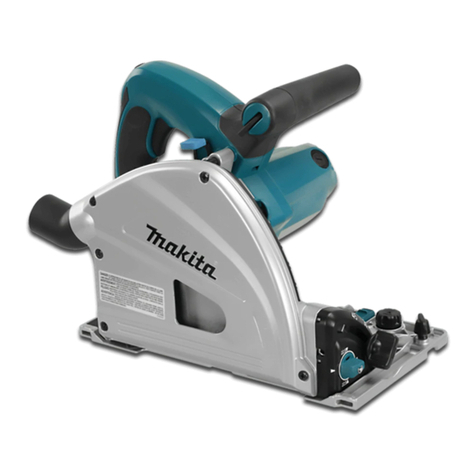
Makita
Makita SP6000 User manual

Makita
Makita LS1016 User manual
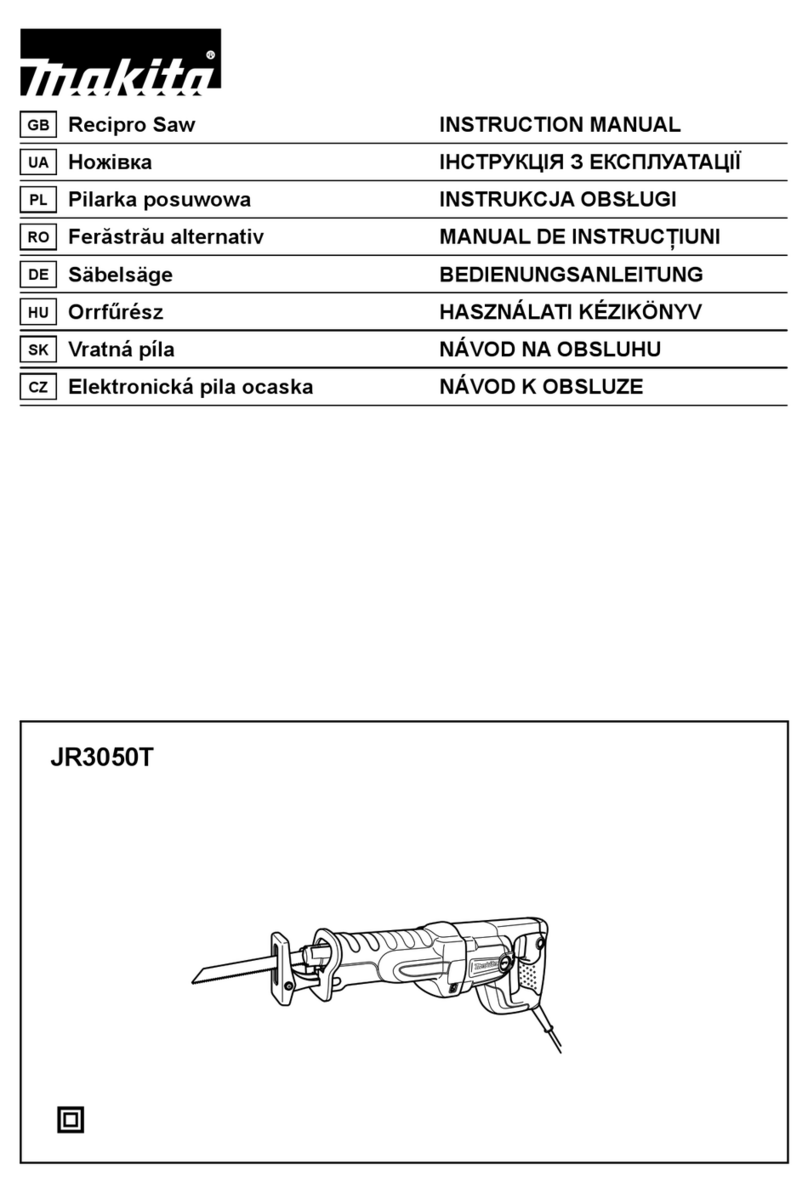
Makita
Makita JR3050T User manual

Makita
Makita 5606B User manual
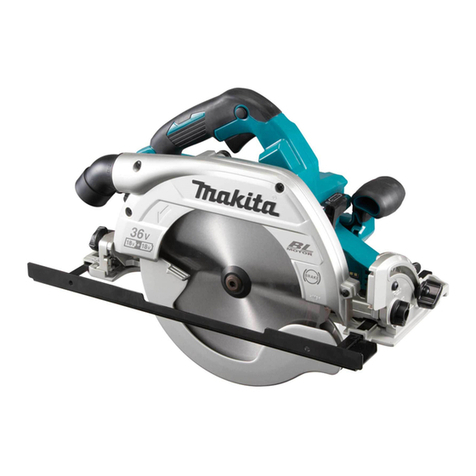
Makita
Makita DHS900 User manual

Makita
Makita 5603R User manual

Makita
Makita 5057KB User manual
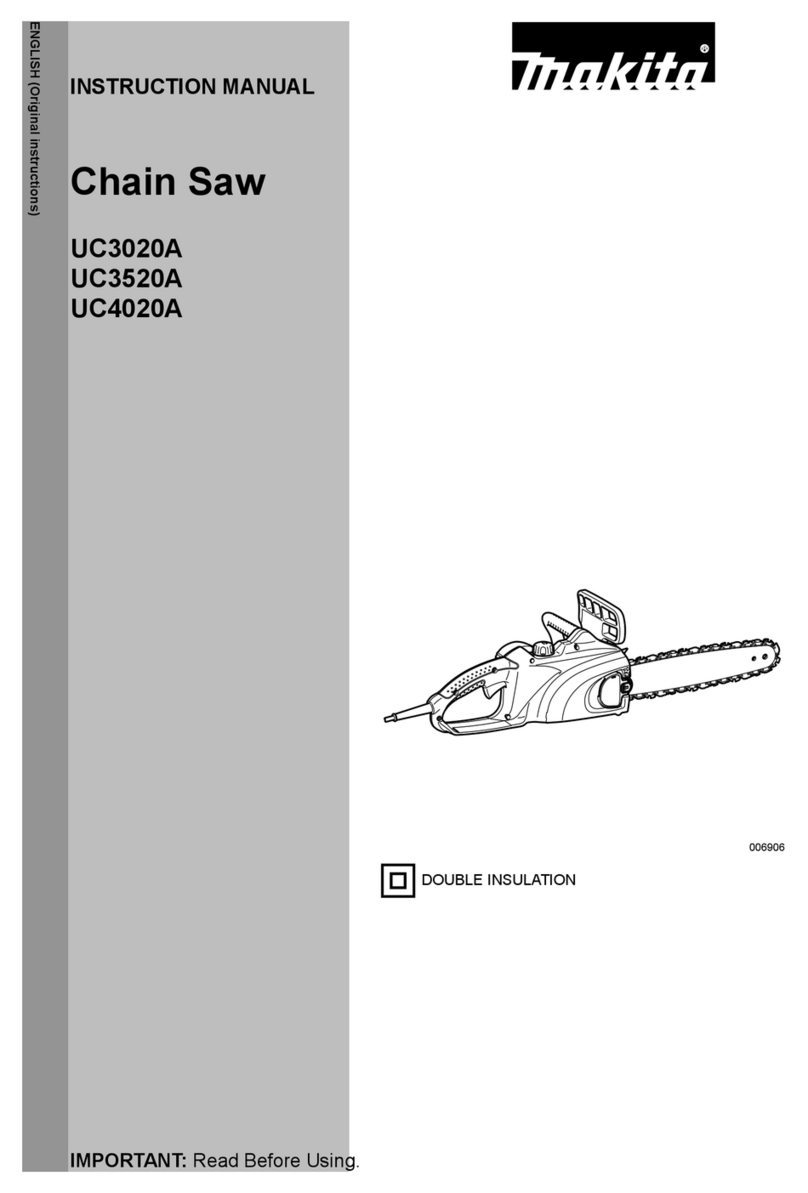
Makita
Makita UC3020A User manual

Makita
Makita HS6100 User manual
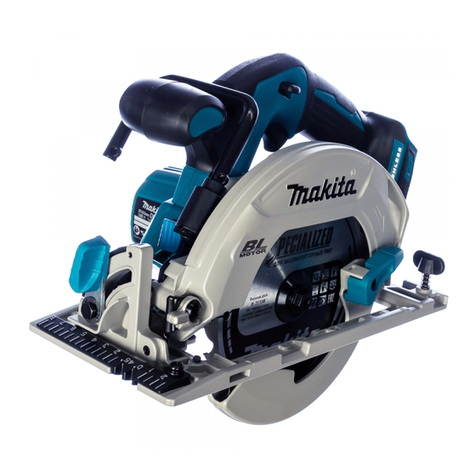
Makita
Makita DHS680 Manual

Makita
Makita XT506S User manual
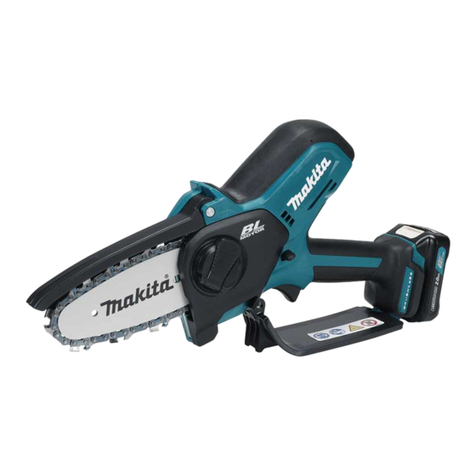
Makita
Makita UC100D User manual
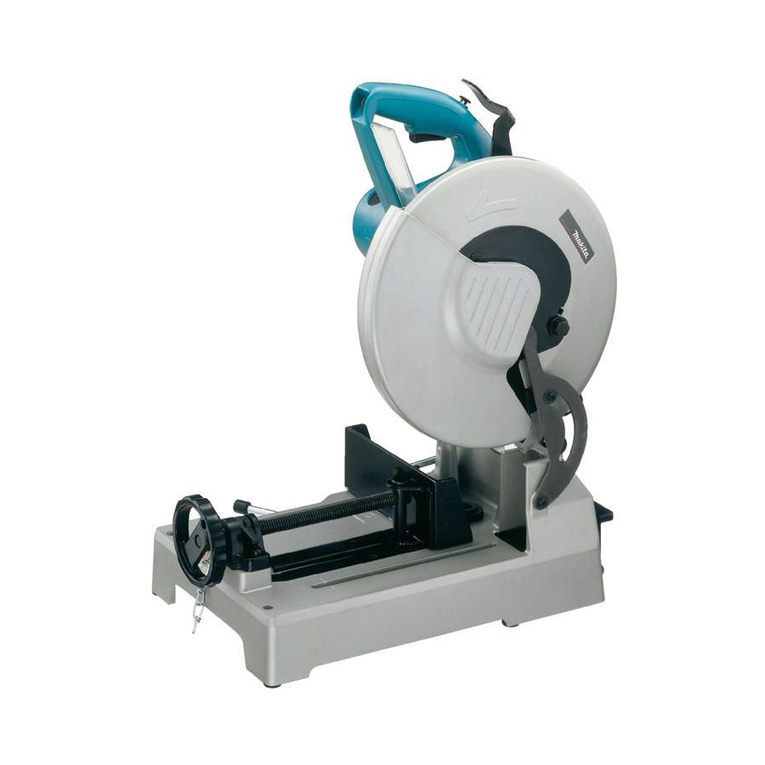
Makita
Makita LC1230 User manual
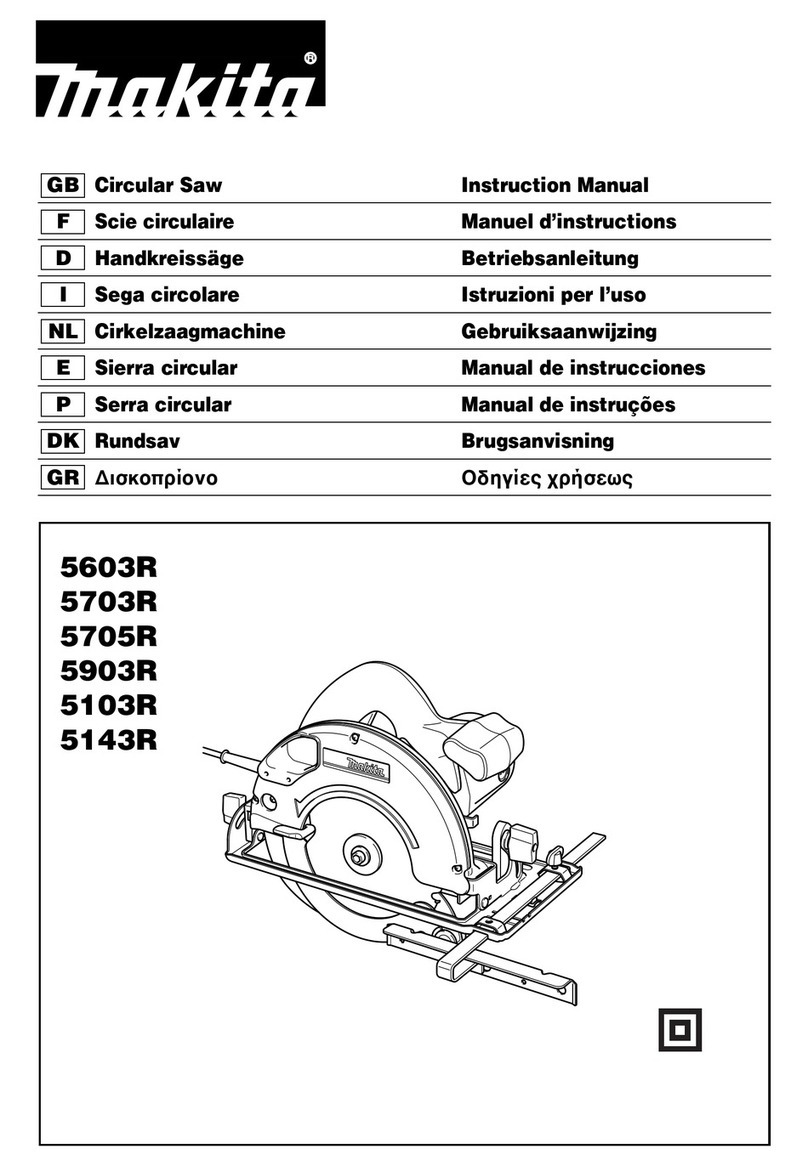
Makita
Makita 5603R User manual

Makita
Makita HS7601 User manual
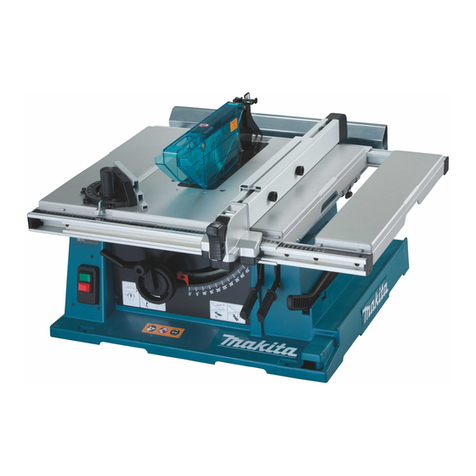
Makita
Makita 2704N User manual
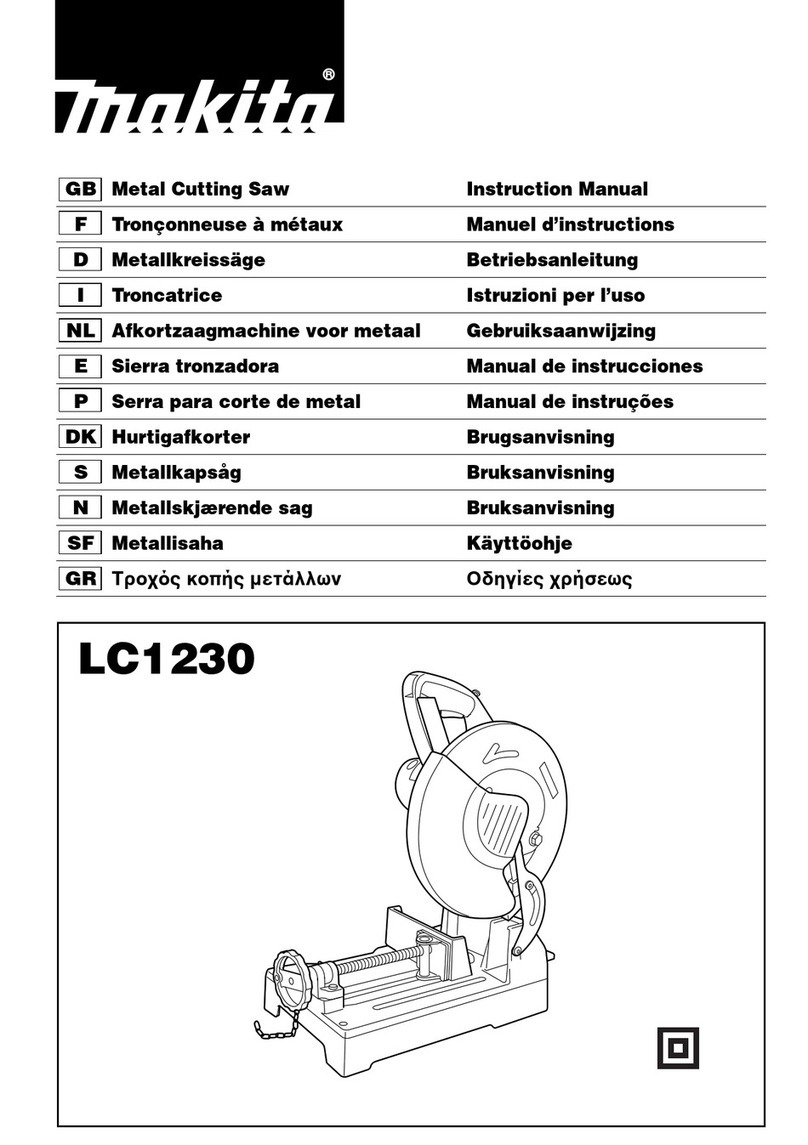
Makita
Makita LC1230 User manual

Makita
Makita 5077B User manual

Makita
Makita JR1000FT User manual
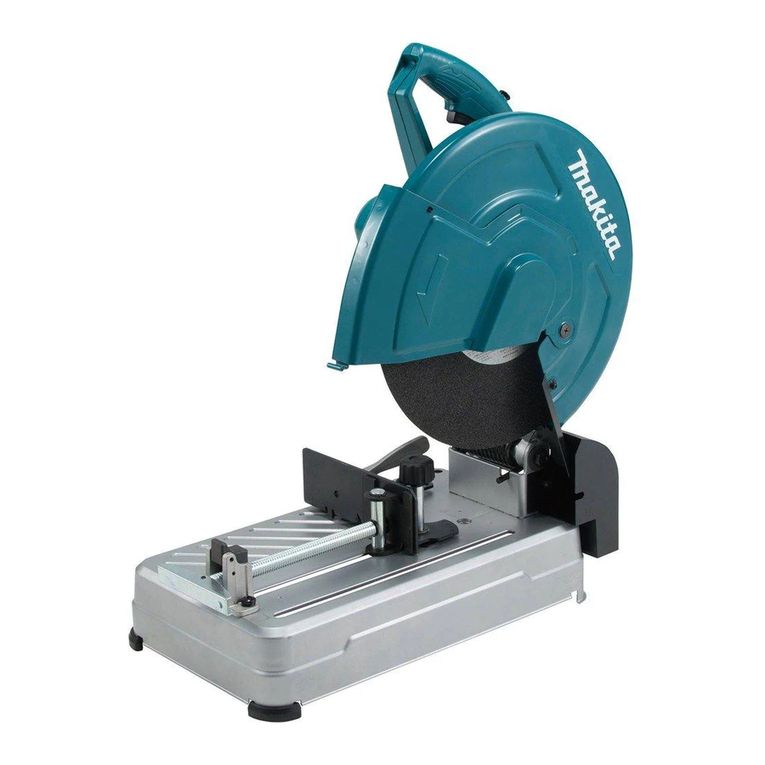
Makita
Makita LW1400 User manual
